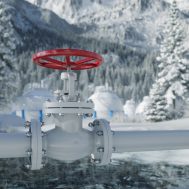The winter weather season is near, bringing cold temperatures and, depending on your location, snow and ice. Aside from causing us to grab our jackets, clean off our cars, and shovel out a path on the sidewalk, winter can cause inconveniences and problems in an unexpected place: industrial equipment. To keep machinery operating properly, high-quality rubber components can be a proper solution.
Winter’s Effects on Industrial Machinery
Daily winter temperatures can easily reach freezing (32°F/0°C) or lower, causing machines to be exposed to cold air or gases and potentially stall or not start. Low temperatures also contract elastomeric materials, leading to possible leakage and decreased compression. Batteries can lose their power much faster in these chilly conditions, resulting in lower effectiveness and potential machine failure. Additionally, o-rings can experience shrinkage, brittleness, loss of flexibility, or reduced compression if exposed to extreme cold.
Many machine parts are affected by weather. Displays can crack or get damaged from extreme cold. Fluids can thicken, making them unable to flow or be processed. Melting snow or ice can cause water to collect and leak into machinery, damaging internal parts or electronics. If any of this happens, or if multiple factors occur together, it can lead to physical or financial damage, among other issues.
Using Rubber to Fight the Cold
Silicone is a good fit for stability and flexibility by offering low-temperature resistance. It can retain its elastic function in temps as cold as -50°C (-52°F) and not lose its sealing properties. With its excellent weathering characteristics and incredible resilience to ozone and UV, silicone can be used in machinery or components that need to be exposed to the elements, such as those operating in extreme cold or moderate winter weather.
Another good weatherproofing fit is Ethylene-Propylene (EPDM). This synthetic rubber can withstand temperatures as low as -50°C (-58°F), making it a good choice for use in the cold. EPDM is also extremely water-resistant thanks to its internal structure; its tight seal keeps out and protects machinery from potential damage from snow or ice, whether it’s fresh or melting.
How to Plan Ahead for Winter
Machines need to have weather-resistant rubber seals. Numerous factors can plague an ill-equipped seal, including contracting that leads to cracking and damage, as well as ripping and tearing. All of these can reduce the effectiveness of a machine. While steps can be taken to try and avoid seal failure, like storing them in a warm (preferably room temperature) and dry place before usage, not using a seal meant for colder weather can lead to machine damage in time.
Before winter arrives, inspect machinery to ensure it’s ready for the cold. Check every rubber part, like gaskets, for cracks or damage. Even during the winter season, perform weekly or biweekly inspections to verify all seals and rubber parts continue to function properly. Protect machinery through preventive maintenance and measures before temperatures drop.
Contact Us
Looking to work with us? Reach out to us here.
